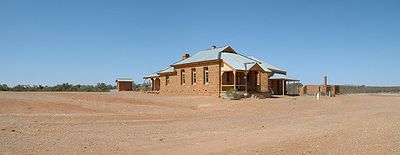
Milparinka, New South Wales
Encyclopedia
Milparinka is a small settlement in north-west New South Wales
, Australia
about 250 kilometres (155 mi) north of Broken Hill on the Silver City Highway
. At the time of the 2006 census
, Milparinka had a population of 55 people.
 In 1844 Charles Sturt's
In 1844 Charles Sturt's
expedition was stranded for six months at nearby Preservation Creek, owing to a lack of supplies. Gold was discovered in the 1870s and a rush commenced in 1880. The mostly male population peaked at 3,000, with William Henry John Slee
(known as WHJ Slee) being appointed resident Goldfields Warden in January 1881. Cobb and Co coaches ran three times a week from Milparinka to Wilcannia, and by August 1881 the official gold escort had carried about 10,000 ounces of gold from the field, not to mention that which went privately.
In this arid region, water was so scarce that miners got their gold by dry blowing. Water was selling for one shilling per bucket and dysentery
was rife, until in September 1881, on the recommendation of WHJ Slee, the New South Wales government authorised the drilling of a well. In December 1881 the government well struck water at 140 feet, which caused great relief to all.
New South Wales
New South Wales is a state of :Australia, located in the east of the country. It is bordered by Queensland, Victoria and South Australia to the north, south and west respectively. To the east, the state is bordered by the Tasman Sea, which forms part of the Pacific Ocean. New South Wales...
, Australia
Australia
Australia , officially the Commonwealth of Australia, is a country in the Southern Hemisphere comprising the mainland of the Australian continent, the island of Tasmania, and numerous smaller islands in the Indian and Pacific Oceans. It is the world's sixth-largest country by total area...
about 250 kilometres (155 mi) north of Broken Hill on the Silver City Highway
Silver City Highway
The Silver City Highway is a highway in the state of New South Wales, Australia. It runs from south to north close to the western border of New South Wales with South Australia...
. At the time of the 2006 census
Census in Australia
The Australian census is administered once every five years by the Australian Bureau of Statistics. The most recent census was conducted on 9 August 2011; the next will be conducted in 2016. Prior to the introduction of regular censuses in 1961, they had also been run in 1901, 1911, 1921, 1933,...
, Milparinka had a population of 55 people.

Charles Sturt
Captain Charles Napier Sturt was an English explorer of Australia, and part of the European Exploration of Australia. He led several expeditions into the interior of the continent, starting from both Sydney and later from Adelaide. His expeditions traced several of the westward-flowing rivers,...
expedition was stranded for six months at nearby Preservation Creek, owing to a lack of supplies. Gold was discovered in the 1870s and a rush commenced in 1880. The mostly male population peaked at 3,000, with William Henry John Slee
William Henry John Slee
William Henry John Slee, FGS, , Australian geologist, mines inspector, mining warden, was born Wilhelm Heinrich Johann Slee on 3 May 1836 at Rostock, Mecklenburg-Western Pomerania, Germany, a son of Jacob and Regina Slee. More usually known as W.H.J...
(known as WHJ Slee) being appointed resident Goldfields Warden in January 1881. Cobb and Co coaches ran three times a week from Milparinka to Wilcannia, and by August 1881 the official gold escort had carried about 10,000 ounces of gold from the field, not to mention that which went privately.
In this arid region, water was so scarce that miners got their gold by dry blowing. Water was selling for one shilling per bucket and dysentery
Dysentery
Dysentery is an inflammatory disorder of the intestine, especially of the colon, that results in severe diarrhea containing mucus and/or blood in the faeces with fever and abdominal pain. If left untreated, dysentery can be fatal.There are differences between dysentery and normal bloody diarrhoea...
was rife, until in September 1881, on the recommendation of WHJ Slee, the New South Wales government authorised the drilling of a well. In December 1881 the government well struck water at 140 feet, which caused great relief to all.

